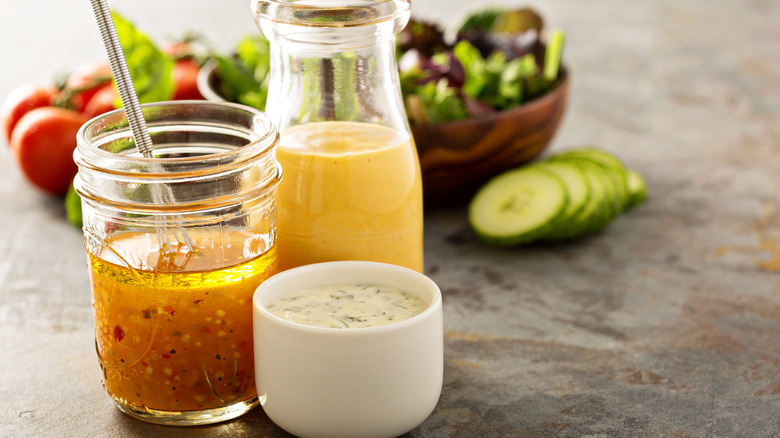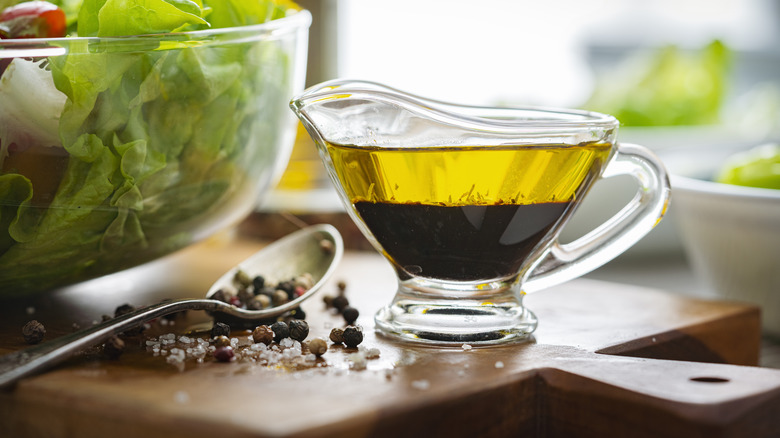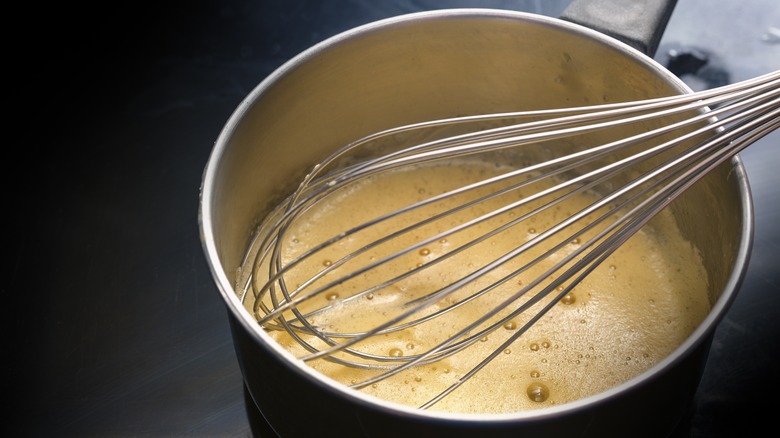What's The Difference Between A Temporary And Semi-Permanent Emulsion?
Every time you whisk together mayonnaise or form a pan sauce, you are dealing with an emulsion. Defined as a mixture of liquids suspended together, it's easiest to explain what happens in an emulsion by picturing a jar of oil and vinegar. The shaking action physically breaks the oil up into beads that briefly intermingle with the acetic acid, but given some time to settle, they find their way back to each other again and float as a single layer on top.
This is considered a temporary emulsion, as it separates within minutes or hours. There are also semi-permanent emulsions, which can take many hours or days to fully divide back into its constituent parts. Time is really the critical factor between the two.
For semi-permanent emulsions, it's common that another ingredient helps with the suspension, like mustard in a vinaigrette. The protein in mustard can grab onto both oil- and water-based vinegar at the same time, keeping them joined for longer, resulting in a dressing with a thicker, creamier texture. Unlike mayo, which is usually a permanent emulsion because of the added lecithin, a mustard-based dressing will eventually separate again.
Temporary emulsions are made to be broken
Temporary emulsions are easy to make by shaking the components together in a container or whisking with a fork. No special ingredients are needed, and you don't need to take precautions to keep the mixture from breaking, as that's what's expected. A temporary emulsion can be many ingredients or just two, but if any of the other ingredients are what's keeping the mixture together, it's no longer considered temporary.
The oil and vinegar-based salad dressings we've described are the most common culinary temporary emulsions. If you've ever shaken butter into your coffee or tried to whisk in olive oil, chances are you've seen little pools of oil on top of the drink as you sip it — that's a temporary emulsion also. Fat washing a bottle of whiskey starts as a temporary emulsion of melted butter added to alcohol. After the flavors have time to transfer, cooling the mixture separates out the solid butterfat — exactly what we want when creating this temporary combination.
Semi-permanent emulsions are stronger, but still breakable
Once a stabilizing ingredient is added to an emulsion to hold it together longer, you'll have more time to use the mixture before it separates: thus the name semi-permanent. Returning to the salad dressing example, a bit of mustard will bind it for an hour or two, but a spoon of mayonnaise shaken into the ingredients will make a much longer-lasting combination. The egg yolks in mayonnaise (which itself is a permanent emulsion) are also very effective at holding together liquids.
But a semi-permanent emulsion will break apart if it's not treated carefully, usually that mistreatment involves heat. Several sauces made from butter are notorious for breaking apart over high heat: Hollandaise and butter-finished pan sauces. Both are semi-permanent emulsions of butter oil and a flavorful liquid — lemon juice in the case of Hollandaise and the pan jus for the other. Egg yolks hold the Hollandaise together, but overheating turns the silky sauce into a disappointing oily mess. Butter alone can create a semi-permanent emulsion pan sauce because of its milk proteins but if the pan gets too hot, the sauce separates again. Semi-permanent emulsions might be a bit tricky to master, but the smooth texture and silky mouthfeel are well worth the effort.


